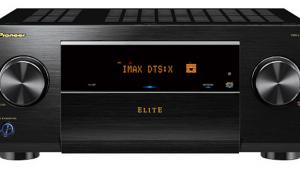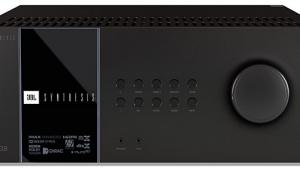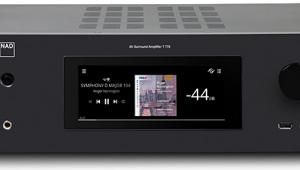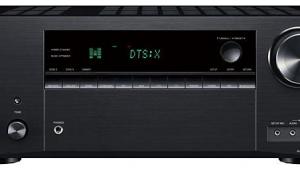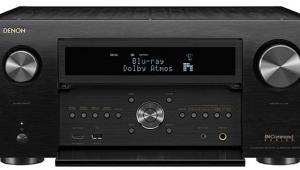Denon AVR-A1H Review: Multichannel Mastery

AT A GLANCE
Plus
15 x 150 watts of power
Audyssey and Dirac (extra-cost) room correction
Comprehensive surround and up-mixing abilities
Flexible amplifier, channel assignments
HEOS multiroom/streaming ecosystem
Minus
No system-wide user-presets
HEOS streaming omits some services
THE VERDICT
A flagship AV receiver fully worthy of the name.
Clicks on our links may earn us a commission. Thank you for your support.
Remember when cars ran on gasoline, cell phones flipped, and you needed a forklift to get a flagship-model AV receiver onto your equipment rack?
Denon does. Its new pennant-flying model, the AVR-A1H, clocks in at an impressive 71 pounds. And while I managed to hoist our sample onto my rack unaided—mostly because I was too abashed to ask for help—if I’d had a forklift I for damned sure would have used it.
Features
To say that the AVR-A1H is fully featured is like saying that Shohei Ohtani is multitalented. If you can think of it, the new Denon flag probably does it. But the lead story has to be this: Fifteen. As in 15 channels of on-board, built-in amplifier power, ready to drive a 15-channel Dolby Atmos, DTS:X, Auro-3D, or IMAX system, or an 11-channel system with two stereo remote rooms, or any of the myriad other configurations you can dream up. And those 15 channels are all identically powered, rated at 150 watts full-band 0.05% distortion (two-channels driven).
All these channels require a truly massive main power transformer and, of course, a lot of output transistors and attendant heat sinks: hence those 71 pounds. Fifteen powered channels put the AVR-A1H at the top of the AV receiver-power heap, aside from a very few, very expensive (twice the Denon’s cost and up) and fairly esoteric designs featuring 16 or more channels. Moreover, the AVR-A1H can command up to four discrete subwoofers, each independently addressable via Dirac Live Bass Control, which we’ll get to.
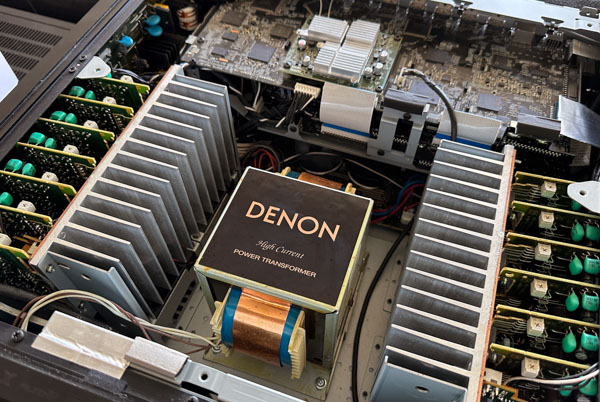
Visually, the AVR-A1H departs not one iota from Denon’s familiar, two-knob design language. There’s a drop-hinged door to conceal the few direct-access buttons and the five-way rocker to navigate menus: obviously, all these functions will typically be performed on-screen in real life. It’s conventional and unadventurous but perfectly handsome and eminently workable.
Around back is the thicket of connections you’d expect from a 15-channel AVR: 17 pairs of decently hefty multiway speaker binders (the extra pairs allow for versatility in multichannel/multiroom setup options), seven input and three output HDMI jacks, and five analog-stereo audio inputs, one of which is for a phono source, and another of which can select balanced XLR jacks. There are correspondingly 17 unbalanced audio outs, all on RCA jacks, matching the speaker complement, and four discrete subwoofer outputs, all of which can be served via unbalanced RCA or balanced XLR jacks. (There are also two stereo zone pre-outs on RCAs.) I understand the attraction of a balanced-line option for the subs, the only channels that might encounter hum pickup over long cable runs, but that’s a lot of panel real estate for what I’d guess will be a seldom-used feature.
Digital facilities, in addition to the HDMI complement, comprise two optical and two coax SPDIF inputs, an Ethernet jack, and a USB input (for fixed storage) on the front panel (there’s a second, charge-only USB port on the rear panel). Add two 12v trigger jacks, remote/IR (infrared) in/out, and a two-wire IEC power inlet, and we’re done.

Once my lactic acid levels returned to normal after heaving the big Denon atop my rack, I wired up a 13-channel surround system peopled by my usual 5.4.1 loudspeaker array, plus two “extra” pairs of small two-ways functioning as front-wide and rear-surround channels. (These were Polk Audio OWM3s, a surprisingly accurate, subcompact, flexible-mount two-way that Polk has wisely kept in its lineup for nearly 20 years.) I eschewed adding a third pair of height speakers because a) my room isn't big enough to need them, b) I had no practical place to put them, and c) I was now flat out of small speakers. Making all this happen required only keeping track of a great many speaker wires, jacking the AVR-A1H into my rack-side Ethernet switch—the receiver can also use its onboard Wi-Fi, of course, but I prefer wired when available—and connecting my AV HDMI sources: a cable-box and a 4K Blu-ray player.
The next step was system setup/room correction. Like all of Denon’s (and sister-brand Marantz’s) higher-level AVRs, the AVR-A1H includes Audyssey’s premier option, MultEQ XT 32, as well as Dirac Live as another option for an extra buy-in of $259 (and up).
I ran Audyssey twice: once directly from the AVR-A1H, which does the full analyses and correction but does not let you view or modify the resultant curves; and subsequently from the MultEQ XT app (iOS), which performs precisely the same functions and filtering results, but allows you to view the pre- and post-correction curves (though not with great detail), and to choose from two “house” curves (treble roll off), and to delineate how far into the high-frequencies you wish correction to extend. Pretty nerdy, I know: the takeaway is that the data results were virtually identical—as expected—and Audyssey got all my speaker sizes, distances, and levels bang on the money. Crossovers for my main L/R and surrounds were set a bit higher than I usually choose, but on an initial listen I heard nothing amiss with this arrangement. (I eventually reset my main-channel high-pass to 60 Hz, as I usually employ.)
Dirac has been amply covered in these pages recently, so I will quickly review: The procedure requires an outboard computer or smartphone/tablet, and is a bit more involved and a good bit fussier than Audyssey. The results—levels, crossover distances—were substantially identical, unsurprisingly. (The measured curves Dirac displayed also closely matched those of the MultEQ XT app as displayed on my iPad.) As to differences in correction result: it’s very difficult to say, since direct comparisons via the AVR-A1H require a trip to the setup menu, into the Speakers page, and then to the Preset submenu, with a subsequent several-seconds delay. I will say I judged the results very close, though probably not identical.
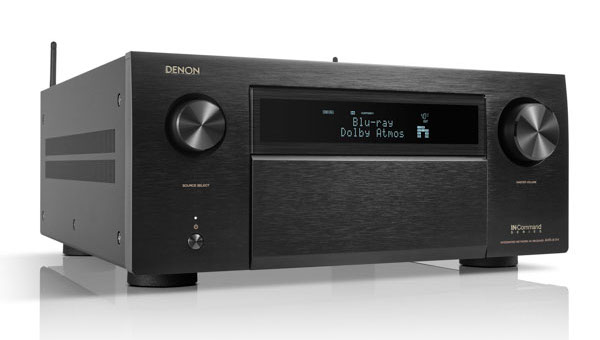
But in either case, and in common with any competent room-correction system, the biggest benefit by far was the mitigation of two prominent room modes astride the 100 Hz point in my studio. The difference, with either Audyssey or Dirac, was plain to hear: tighter, more tonally defined bass, and more lifelike, less bloated rumbling from full-range ambience, audible on film soundtracks, of course, but also clearly noticeable on things like newscast street-corner stand-ups. Both systems also delivered the finer-grained, more organic, in-the-ambiance sound of upper-midrange/low treble sounds, voices and instruments alike, that I’ve long noted from successful room correction routines, a fringe benefit of reducing the bass build-up induced by room modes.
But there’s more: this was my very first waltz with Dirac’s Live Bass Control, which adds the ability to integrate multiple subwoofers, at multiple positions, to deliver optimal low frequencies in the room by integrating levels, crossovers, and time-domain (phase) to form a single low-frequency “engine” that’s best aligned to your particular speakers’ capabilities, and your room.
I have three subs on hand: my system’s regular compact, 20 Hz-capable unit which meets my everyday needs amply as long as I don’t go full reference-level, which I almost never do; an almost-equally adept 10-inch job from the rarely used TV room (my wife, its most frequent user, is almost certain not to notice its absence, and would probably welcome it if she did); and another 10-incher that lives under my desk, adding an octave or so to my desktop monitors.
I hauled the TV-room sub into my studio and placed it about a third of the way along the left-hand long wall, while my everyday sub remained in its well optimized position about a meter out of the right-hand corner, fairly close to the right-front speaker. The second 10-incher I left under my desk about midway along the right long wall, merely re-routing it to a long RCA cable snaked along the perimeter of the room to avoid tripping and killing myself. (Ask me how I learned to do this always with “temporary” cables.)
The Dirac Live Bass Control calibration process, once I’d re-measured the system with the three subs in place, is fairly straightforward, but the tuning options are more than we can go into here and, frankly, probably more than the average, non-audio-geek homeowner/home-theater user will likely want to undertake; that’s what custom-install pros are for. But the results were pretty clear: smoother, completely non-localizable bass, better deep-note pitch definition on music, and less “bloom” (or boom) on film sound effects. But to me, Bass Control’s greatest virtue was evident on Atmos concert-hall recordings, which produced the rolling, space-reverberant, timbrally rich low-end that you hear in an actual concert hall, but that even very high-end systems (including mine) struggle to master. (This was music I mostly streamed from Apple Music via my Apple TV/4K box. Classical from Apple Music, as opposed to Apple Classical, is a bit of a scavenger hunt: annoyingly Apple still doesn’t have an Apple Classical app for the TV/4K, which you absolutely need to stream Atmos music to a multi-speaker system—casting from a phone or iPad is only stereo, an AirPlay restriction. But I’m getting a little off topic….)

Dirac’s price structure is four-tiered from $259 for the most basic, low-frequency-only Dirac Live, to an eye-watering $799 for the full-bandwidth, multi-subwoofer option I was able to use, but to those determined to turn over every rock for improved sound, price is no object. On the other hand, the Audyssey XT32 that the AVR-A1H includes at no extra charge delivers all the prime benefits of room correction in a process that’s considerably more user friendly.
Listening
My initial impression, formed within about 15 minutes of lighting up the big Denon, was that the AVR-A1H is very probably the best-performing AV receiver I’ve used in 25 years of trials. Everything I threw its way sounded, clear, well-balanced, and musical or cinematic.
I always start with stereo, no-subwoofer music, and the Denon’s playback in this garb was fully audiophile-grade. A fine (and oft-cited) recording like “The Blues Walk/Here I Am” from Lyle Lovett and his Large Band highlighted dramatic dynamics from the brass, bass, and drums, but delicately drawn, very-expensive-microphone detail on Lovett’s spoken voice, piano, and guitar.
Surround music was ear-opening, doubtless in no small part due to my upgrading to the 13-speaker layout. (The addition of Front Wide speakers, which my long-ago colleague Tom Holman, of THX fame, has long advocated, made a very real contribution to hall-sound vitality and proscenium spatiality.) A nicely produced rendering of Rachmaninoff’s “Symphonic Dances” (Berlin Philharmonic, Apple Music/Atmos) put me about 20 rows back on the floor, with the air, height, and breadth of the hall, and aforementioned bass richness all palpably evident, while timbres from the famous density of the Berlin strings to the exciting presence and bite of the brass were entirely convincing.
Of course, I listened to some non-classical Atmos music as well. The tasteful Atmos remaster of the Fleetwood Mac chestnut “The Chain” (do us boomer reviewers ever listen to anything else?) ably demonstrated how well-applied spatial audio can make it easier to tease out the various musical strands of a song: in this case, Lindsey Buckingham’s multiple guitar parts. Distributed artfully across the full front hemisphere, the distinct timbres and articulations of each were much clearer than in stereo. Spatial is not a guaranteed win, however: I found the Atmos rendition of U2’s “Mysterious Ways,” a tune that sounds just-okay in its original stereo, to come across as frankly harsh and unpleasantly gimmicky.
I judged Apple/Spielberg’s/Hanks’ final WWII epic Masters of the Air disappointingly wooden and anachronistic, with far too many dialogue lines and haircuts you’d never have encountered in the 1940’s. But you can’t fault its Atmos soundtrack’s action scenes for spatial effects. All the dogfights, fly-bys, and chattering machine guns and explosions were quite mesmerizing, and the AVR-A1H reproduced them faultlessly through my 13 speakers—none of which could really be called high-sensitivity—at reference level without the least sign of effort. And, even after a full episode, its top cover was barely warm to the touch, but no more.

Oppenheimer on 4K Blu-ray is, I think, a must-own disc. This despite the fact that Christopher Nolan’s opus is only a 5.1-channel (DTS) soundtrack, though on the upside this made a fine test of the Denon’s upmix to DTS Neural/X—and the results did not disappoint me in the slightest.
A brief, six-degrees-of-Kevin Bacon diversion: my dad was there, plucked out of basic training by a possibly life-saving IBM punch card machine (he was likely bound for D-Day) and shipped blind to Los Alamos, New Mexico as T/sgt. scientist/technician. He was much too small a fry to appear in the film (though Kai Bird did spend a day interviewing him for American Prometheus, the book from which the movie was derived), but his boss and former professor, George Kistiakowsky, does, in a minor role.
Oppenheimer is as meticulous an audio-video production as Hollywood can provide, and the big Denon did it full justice. In its upmixed DTS Neural/X 13-channel form, the detailed spatialization was impressive: the tighter, more claustrophobic ambiance of the black-and-white scenes, vs. the expansive, outdoors ambiance of the colorful New Mexico scenes, was precisely reproduced. And, of course, the relatively few big-audio scenes—mostly, unsurprisingly, explosions of one sort or another—presented with awesome breadth, power, and…well, awesomeness.
And All (or at least some of) the Rest
Clearly, I found no sound-quality (or quantity) issues from the AVR-A1H, but there’s more to any AV receiver than audio performance (and room correction). Denon delivers the usual three-zone abilities, including HDMI output to a secondary room. It also delivers 8K throughput and upscaling of 4K, if anybody cares (I don’t). More important in my book are the Dolby Vision and HDR10+ video-dynamic-range enhancement modes and the VRR (variable refresh rate)/ALLM (auto low-latency mode) for lag-free gaming (gamers will know what this means better than I do).

Perhaps most saliently, the big AVR-A1H fully participates in Denon/Marantz’s HEOS multiroom/streaming ecosystem, which recently received a significant update to its various apps. I downloaded the latest iOS HEOS version to my iPhone XS and dug in.
HEOS’ layout is now simpler and more intuitive: finding the streaming service, Internet-radio stream (via TuneIn), or local server if you have one is more straightforward, as is navigating track info. Major streaming services, including Spotify, Pandora, and Tidal, are baked in—but not, unfortunately, the two to which I subscribe: Qobuz and Apple (Music) Classical. So I signed in on Amazon Music for a go, and found a reasonably responsive track and playlist response, and easily navigated design. Digging deeper into a service’s offerings is still a bit “pagey,” but that’s equally true via most smartphone/tablet access points.
HEOS integrates the AVR-A1H’s multiroom capabilities in a simple and accessible screen. I played with this briefly, temporarily using my front-side speakers as “Zone 2,” and found it straightforward. However, I can’t comment on its usability with Denon/Marantz HEOS wireless speakers or its Sonos compatibility, which is another major selling point.
While we’re in the streaming aisle, the big Denon’s Roon compatibility is limited to “Roon Tested,” which means it participates via AirPlay or Chromecast, not as a direct, hi-rez-capable endpoint. A little disappointing—or not, depending on your belief system regarding hi-rez audio. For whatever it’s worth, I listened extensively via Roon/AirPlay and had no complaints.
Now a few items from the “extra stuff” column: Denon supplies three bonus spatial-sound modes: IMAX Enhanced (which includes video “enhancements”), Auro3D, and 360 Reality Audio—all rewarding to play with. A valuable Info command instantly steps through three screens of detailed reports on the currently selected input, audio and video content settings and modes. Alexa, Siri, and Google Home compatibility are all on tap—none of which I fooled with since I am simply too 20th-century to talk to a machine. Audyssey’s companion functions Dynamic Volume and Dynamic EQ, both of which I rate highly for real-world utility, are on board.

The Denon AVR free app (iOS/Android) provides an alternative to the supplied remote control and includes a web-control page that can access a level of geeky settings and function detail unavailable otherwise. There’s two-way Bluetooth, for listening (main zone) via wireless headphones or speakers. And finally, two (but only two) Speaker Preset registers store combinations of speaker configurations, levels, distances, crossovers, and so on, whether derived manually or via Audyssey or Dirac.
This last raises the one salient—to me, anyway—absence on the AVR-A1H’s long features list: It lacks a global preset option, by which combinations of input, surround-mode and other modes, speaker settings, channel-level tweaks, and more can be stored for one-touch recall. Several competing brands—including, puzzlingly, sister-marque Marantz—include such a function, usually with four or more registers. Since I almost always favor slightly different setups for music vs. movies (and classical or jazz vs. pop or rock), streaming radio vs. hi-rez playback, and so forth, I rate these features highly. Why none such is found on the AVR-A1H is a mystery.
But that’s about the only gap I could identify in the AVR-A1H’s dossier. In every other regard that matters, this is a flagship AV receiver that delivers the flag—and the firepower—to satisfy any would-be AV admiral. Sure, it’s expensive. But short of dropping 20 grand on a Storm Audio ISR Fusion 20 (or one of its rebranded equivalents), I’m not sure you can buy more, or better, in a one-box AVR.
SPECS
Power Output: 150 watts per channel (20 Hz-20 kHz, 0.05% THD, 8 ohms
Dimensions (WxHxD, Inches): 17.1 x 7.7 x 18.3 in.
Weight (Pounds): 70.6
Audio Inputs: 7x HDMI (1 eARC), 2 coax, 2 optical digital, 1 USB (front panel media only), 1 charge-only; 4 analog stereo line, 1 XLR balanced, 1 MM phono.
Audio Outputs: 17x speaker (15 active simultaneously: up to 4 assignable to zones); 17.4-channel preamp outputs (assignable Height-2/Zone-3, 2), 4 discrete subwoofer outputs on balanced XLR and RCA, 2 stereo zone line-outs
Video inputs: 7x HDMI
Video Outputs: 3x HDMI (1 eARC, 1 zone)
Wireless: Bluetooth (RX/TX) 4.2 A2DP/AVRCP/aptXHD; Wi-Fi Chromecast, Airplay2
Additional: FM 75Ω "F" antenna; AM-antenna push-terminals; Ethernet (network, control, streaming); RS-232 (control); 2x 12v-trigger; remote in; 2x Bluetooth/Wi-Fi antenna


